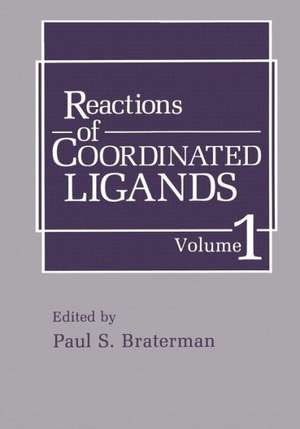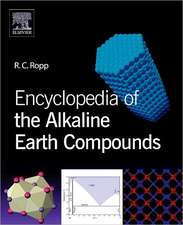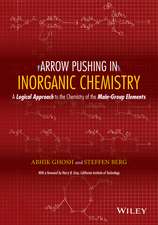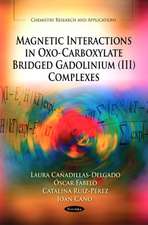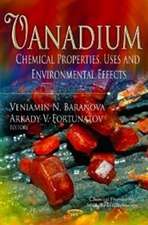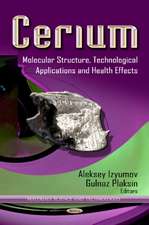Reactions of Coordinated Ligands: Volume 1
Editat de P.S. Bratermanen Limba Engleză Paperback – 9 noi 2011
| Toate formatele și edițiile | Preț | Express |
|---|---|---|
| Paperback (2) | 399.12 lei 6-8 săpt. | |
| Springer Us – 14 oct 2011 | 399.12 lei 6-8 săpt. | |
| Springer Us – 9 noi 2011 | 447.23 lei 6-8 săpt. |
Preț: 447.23 lei
Nou
Puncte Express: 671
Preț estimativ în valută:
85.59€ • 88.85$ • 71.37£
85.59€ • 88.85$ • 71.37£
Carte tipărită la comandă
Livrare economică 22 martie-05 aprilie
Preluare comenzi: 021 569.72.76
Specificații
ISBN-13: 9781461290001
ISBN-10: 1461290007
Pagini: 1068
Ilustrații: 1064 p.
Dimensiuni: 178 x 254 x 56 mm
Greutate: 1.81 kg
Ediția:Softcover reprint of the original 1st ed. 1986
Editura: Springer Us
Colecția Springer
Locul publicării:New York, NY, United States
ISBN-10: 1461290007
Pagini: 1068
Ilustrații: 1064 p.
Dimensiuni: 178 x 254 x 56 mm
Greutate: 1.81 kg
Ediția:Softcover reprint of the original 1st ed. 1986
Editura: Springer Us
Colecția Springer
Locul publicării:New York, NY, United States
Public țintă
ResearchDescriere
This book is aimed at graduate students and research workers in aU branches of ohemistry, who wish to gain insight into what continues'to be one of the fastest growing areas of the subject. Aonding to a metal center may stabilize a ligand towards some reagents, activate it towards others, or modify its chemical behavior in more subtle ways. AU these effects have their uses, and aU invite understanding in terms of mechanism. Thus mechanistic insight is linked to control of reaction pathways. The detailed working out of this relationship provides the central theme of the book. The effect of the metal may be electronic or steric, and may involve the energy or the entropy of activation. It may depend on changes induced in the initial state of the ligand, or on those that only arise further along the reaction pathway. It may involve one coordination site or several, and the effects may be more, or less, specific to the metal involved and more, or less, amenable to control through the other Jigands. These remarks apply equaUy strongly to the carbon-bound ligands which occupy the major part of this work, and to those attached by other atoms. Thus the reactions discussed here are relevant in such diverse areas as bulk homogeneous catalysis, stereoselective stoichiometric synthesis, and bioinorganic chemistry.
Cuprins
1. One-Carbon, Two-Carbon and Three-Carbon Ligands.- 1. General.- 2. Thermochemical Studies.- 3. One-Carbon Ligands.- 4. Alkene Complexes.- 5. Formation and Reactions of n3-Allyl Complexes.- 6. More Recent Developments.- References.- 2. Reactions of One-Carbon Ligands in Complexes of Macrocycles.- 1. Types of Ligand Encountered.- 2. Homolytic Cleavage of the Carbon-Metal Bond.- 3. Reactions with Electrophiles.- 4. Reactions with Nucleophiles.- 5. Unimolecular Rearrangements.- 6. Summary.- References.- 3. Alkylidene Complexes of the Earlier Transition Metals.- 1. Introduction.- 2. Types and Methods of Preparation.- 3. NMR and IR Studies.- 4. Structural Studies.- 5. Decomposition Studies.- 6. Reactions.- 7. Calculations.- 8. Recent Developments.- References.- 4. Carbene Complexes of Groups VIA, VIIA and VIII.- 1. Introduction.- 2. Synthesis.- 3. Structure and Bonding.- 4. Reactions with Nucleophiles.- 5. Reactions with Electrophiles.- 6. Reactions of Transition Metal Carbene Anions.- 7. Addition-Rearrangement Reactions.- 8. Redox Reactions without Metal Carbene Cleavage.- 9. Cleavage of the Metal Carbene Bond.- 10. Carbene Transfer Reactions.- 11. Carbonyl Carbene Complexes as Bifunctional Reagents.- 12. Carbonyl Carbene Complexes in Organic Synthesis.- 13. More Recent Developments.- References.- 5. Mechanistic Aspects of the Olef in Metathesis Reaction.- 1. Introduction.- 2. The Metallo-Carbene Mechanism.- 3. Mode of Formation of the First Metallo-Carbene.- 4. The Metalla-Cyclobutane and Metalla-Cyclobutene Intermediates.- 5. Sterochemistry of the Reaction.- 6. Electronic Nature of the Chain-carrying Carbene in Olefin Metathesis.- 7. Conclusions.- References.- 6. Carbonylation and Related Chemistry: Some General Aspects.- 1. General.- 2. The Carbon Monoxide Insertion Reaction.- 3. External Nucleophilic Attack on CO.- 4. Metal Acyls as Bases.- 5. n2-Bound Acyl Ligands and Related Species.- 6. Aldehyde-Hydridoacyl Interconversions.- 7. Ketone Elimination Reactions.- 8. Miscellaneous.- 9. More Recent Developments.- References.- 7. Promotion Effects in Transition Metal-Catalyzed Carbonylation.- 1. Introduction.- 2. Substrate Structure and Substituent Effects.- 3. Ligands.- 4. Solvent, Ion Pair, Acid and Base Effects.- 5. Oxidants and Reductants.- 6. More Recent Developments.- References.- 8. Hydride Transfer to Coordinated Carbon Monoxide and Related Ligands.- 1. Introduction.- 2. The Carbon Monoxide Ligand.- 3. The Carbon Monosulfide Ligand.- 4. The Carbon Monoselenide and Carbon Monotelluride Ligands.- 5. The Isocyanide Ligand.- 6. Conclusion.- 7. More Recent Developments.- References.- 9. Reactions of Coordinated Isocyanides.- 1. Introduction.- 2. Bonding and Reactivity.- 3. Substitution Reactions.- 4. Reactions with Nucleophiles.- 5. Reactions with Electrophiles.- 6. Insertion Reactions.- 7. Organic Synthesis via Metal-Isocyanide Complexes.- References.- Additional References.- 10. The Formation and Reactions of Metallacycles.- 1. Introduction.- 2. Formation.- 3. Reactions.- 4. Metallacycles as Intermediates.- 5. More Recent Developments.- 6. Conclusions.- References.- 11. Nucleophilic Attack on Coordinated Alkenes.- 1. Introduction.- 2. Palladium and Platinum Olefin Complexes.- 3. Nickel Olefin Complexes.- 4. Cobalt and Rhodium Olefin Complexes.- 5. Iron Olefin Complexes.- 6. Ruthenium and Osmium Olefin Complexes.- 7. Manganese and Rhenium Olefin Complexes.- 8. Molybdenum and Tungsten Olefin Complexes.- 9. Applications in Organic Synthesis.- References.- 12. Asymmetric Additions to Double Bonds.- 1. Introduction.- 2. Asymmetric Hydrogenation.- 3. Asymmetric Hydrosilylation.- 4. Asymmetric Hydroformylation.- 5. Other Asymmetric Addition Reactions.- 6. Some More Recent Results.- References.- 13. Reactions of Coordinated Acetylenes.- 1. Introduction.- 2. Structures, Bonding and Reactivity.- 3. Reactions of Coordinated Acetylenes.- References.- 14. Nucleophilic Attack on Unsaturated Hydrocarbons Coordinated to Transition Metals.- 1. Introduction.- 2. Nucleophilic Addition to Organotransition Metal Cations.- References.- 15. Reactions of Coordinated Dienes.- 1. Introduction.- 2. Electrophilic Addition and Substitution.- 3. Nucleophilic Addition Reactions.- 4. Cycloaddition Reactions.- 5. Ligand Isomerization Reactions.- 6. Catalytic Transformations of Conjugated Dienes.- 7. More Recent Developments.- References.- 16. Reactions of Five-Carbon and Larger Ligands.- 1. Scope of the Chapter.- 2. Nucleophilic attack on Coordinated Ligands.- 3. Electrophilic attack on n5-, n6-and n7-Complexes.- 4. Metalation Reactions.- 5. Side Chain and Other Organic Reactions of n6-Chromium Complexes.- 6. Redox Reactions.- 7. n6-Borabenzene Complexes.- References.- Abbreviations.
